Short Notices: News In Linux Audio
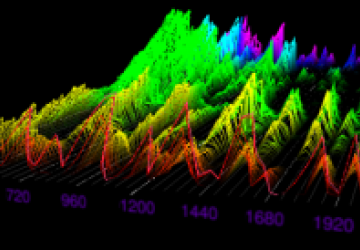
I hope all my readers enjoyed the best of the holiday season. I've been busy with the predictable confusions and minor crises that attend this time of year, but I managed to find time to jot down some recommendations for my readers. Go on, you've been good, give yourself a few extra belated gifts and don't worry if your budget's busted - it's all free software, you can't beat these deals.
"live loop-based MIDI software sequencer intended to aid music composers and performers"
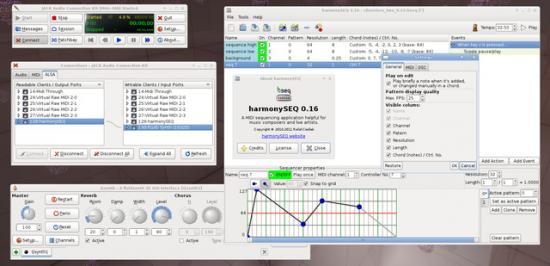
Figure 1. harmonySEQ (Full size)
I built and installed the latest development version 0.16 of harmonySEQ (Figure 1) on a 64-bit Arch system. This "little" sequencer is a straightforward MIDI loop composition environment with some unique features, e.g. a Control Sequence editor for writing MIDI Controller curves and OSC support for remote transport control. HarmonySEQ has also borrowed a page from Dr. Emile Tobenfeld's great Keyboard Controlled Sequencer, i.e. the user can assign sequences to keypresses, a very flexible method for patching together fixed-form compositions or for formal improvisation in realtime performance. However you choose to use it, harmonySEQ is likely to find a permanent place in your Linux MIDI system. For more information see the harmonySEQ home and Louigi Verona's article on his use of harmonySEQ. While you're out there, you should also check out his music improvised with harmonySEQ, it's an impressive display of the program's potential (and the composer's talent).
SunVox
"modular synthesizer with pattern based sequencer (tracker)"
Developer Alex Zolotov calls his SunVox (Figure 2) a "modular music creation studio". It's a light-weight but complete music composition environment that includes a handy set of built-in synthesizers and effects processors. The "modular" in Alex's description refers to the program's module tracker, a music sequencing interface designed originally for music composition programs in the late 1980s. The tracker UI is easy to use and lends itself to complex pattern-based composition, but I should emphasize that any kind of music can be composed with a tracker.
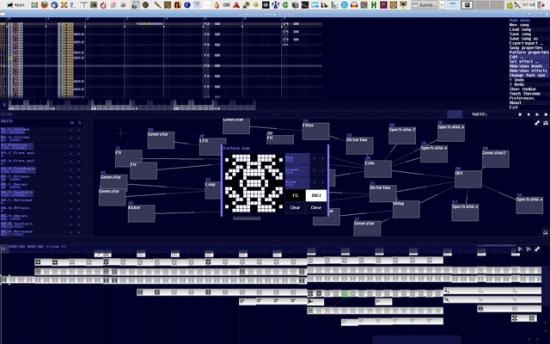
Figure 2. SunVox (Full size)
I tested SunVox for Linux x86 on AVLinux running plain vanilla ALSA. The Linux builds currently support only ALSA (with a fixed sample rate of 44.1 kHz), but support is planned for JACK and OSC. Incidentally, the SunVox package structure has no top directory, so when it's unpacked it spills its contents into the current directory. Save yourself some hassle and create a $HOME/sunvox directory for the zipfile, then unpack the thing there. The better news is that SunVox worked right out of the box. I entered the sunvox/linux_x86 directory, ran the binary located there, and checked out some of the example files in the aptly-named examples directory. Everything just worked, though latency and general performance could be improved by some user-preference tweaks.
A single download includes packages for Linux (x64 and x86_64), Mac OSX, and Windows, along with packages for mobile device systems such as PalmOS and iOS for tracking on the go. A version for iOS can be purchased at Apple's Apps Store. Alas, as far as I can tell, source code is not available.
Aviary's Roc And Myna
"simple but powerful loop composer and audio editor/mixer"
The programmers at Aviary have come up with a variety of cool Web-based applications, including a suite of image processing tools and two programs for audio folk. Roc (Figure 3) provides a simple interface for composing music loops, complete with a palette of immediately usable General MIDI instruments. The program is easy to use - you assign an instrument to a track, then you use a standard piano-roll GUI to select the beats you want played by the instrument. I had fun composing some drum loops and checking out the included example files. I had to join the Aviary Community in order to save my work, but the process was quick, painless, and free. Once my account was in place I could work on loops, save them, and download them as MP3 or WAV files. Those files can then be loaded into Aviary's Myna soundfile editor/mixer (Figure 4) and arranged into song forms. Like Roc, Myna presents a simple interface to a well-designed editor. Myna provides the expected complement of basic edit functions, but it also comes with gain automation and integrated effects processing. No, the effects aren't exactly Bias Peak quality, but they perform well for their intended purposes.
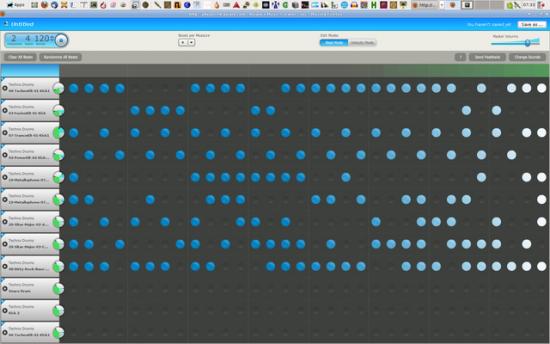
Figure 3. The Roc music creator (Full size)
After saving my files I can re-open them at any time in their respective editors, i.e. patterns in Roc and audio clips in Myna. I can also link my projects to my SoundCloud account, though I'm afraid that my current creations are simple proofs of concept and - so far - not worth posting to the Cloud. However, though my proofs may be simple they indicate clearly that Aviary's software is capable of far more interesting output.
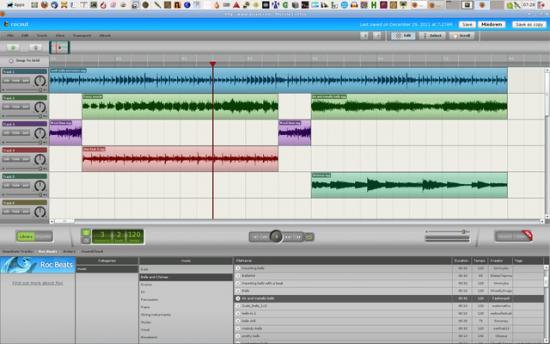
Figure 4. The Myna mixer/editor (Full size)
A final note: I tested the Aviary programs on my 64-bit Arch system with JACK enabled and active. Everything worked perfectly. Kudos to all at Arch and Aviary for work well done.
Ocenaudio
"cross-platform, easy to use, fast and functional audio editor"
The Ocenaudio editor lives up to its site's description. It has a pleasant GUI (Figure 5), quite handsome in full wide-screen display, and it includes a good set of basic editing tools, with some nice touches for its usability, e.g. the Paste Special dialog's presentation of the expected variety of paste operations. The program provides a built-in set of effects and dynamics processors, each with the handy preview option seen in Figure 5. VST support is available for the Mac and Windows version of the program, but there is currently no support for any Linux plugin architecture. There's also no support for JACK and source code is not yet available. Despite these conditions ocenaudio makes another fine addition to your Linux audio toolkit.
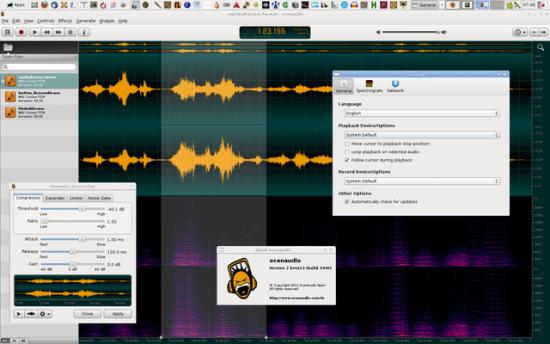
Figure 5. ocenaudio (Full size)
I tested the program on my 64-bit Arch box and on my i586 Ubuntu system. The binary ran without complications with Ubuntu, but I had difficulties with it on the Arch system. I had to convert an RPM to a tarball, then I installed the package to the /usr and /opt directories. Alas, the binary missed libpng12.so.0, but I resolved that problem with a link from libpng14.so.0. Voila, ocenaudio runs nicely on 64-bit Arch. Perhaps the developers will consider adding a standard tarball to their packaged versions ?
Spectrum3D
"displays the harmonics of the sound in 3D"
Long ago I saw a neat screenshot from a program called Spectrogram, written by Alan Peevers. It showed off a colorized waterfall display that apparently analyzed an audio input and represented the results of its analysis in realtime. I say "apparently" because I never got to use the program - it was made for machines built by SGI, and I was unable to completely port Mr Peevers software to Linux. I liked Spectrogram's display, and for many years I've been on the look-out for a similar program. Recently I read about Spectrum3D on the Linux Musicians forum. I checked it out, its screenshots (Figure 6) were very similar to those from Spectrogram, so I downloaded and built the program for three different systems. Alas, it segfaults on my 64-bit Arch box (I'm working on finding out why) but it runs perfectly on my 32-bit Ubuntu and AVLinux installations.
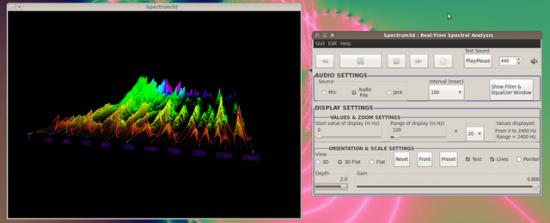
Figure 6. Spectrum3D (Full size)
Has the spirit of Spectrogram come to life at last on Linux ? Well, not quite. The display needs smoother color filling to compare with the SGI program, but I'm not going to complain. Spectrum3D performs nicely as-is - well, it performs nicely on my 32-bit boxes - and I look forward to its future improvement.
More Newsworthy News Items
More items of special notice :
A new beta release of Renoise 2.8 is now available for registered users. Lots of new features, performance improvements, and code fixes. As a result, I anticipate more excellent music from Atte Andre Jensen, a stellar performer with Renoise.
Ardour3 has been in beta for a few weeks. After a lengthy stay at alpha status the project has moved officially into the next level. I've been working with it, it's wonderful, but I warn enthusiastic readers that it is still beta-stage software, it is not a final release. However, it is workable if you're willing to suffer the consequences of testing an early release. Still not scared off ? Cool, then head over to the Ardour site and check out the news on the latest versions available for testing.
As Rui Nuno Capela promised, 2011 was the year his QTractor got automation. It got a lot more than that too, and you can see it all for yourself in the latest incarnation of Rui's wonderful DAW. Gain automation, LV2 support, UI improvements, and much more, just waiting for your creative input.
Csound 5.15 has been released in its various packages. This version includes some new opcodes, improved documentation, more work on the new parser, and the usual bug fixes and performance improvements. The development crew also welcomed new member Tito Latini into the community. I'm happy to see new talent expand the resources available for Csound's development, and at the same time I must express deepest thanks to jpff, Michael G, Steven, Victor, Rory, Matt, Richard D, and every developer who's ever put a line into the Csound codebase. Onwards toward 6.0 !
The Hydrogen drum sequencer has attained beta status for its 0.9.6 release. Hydrogen is a great program, I'm eager to get into this latest version. There are many improvements to its UI and for its overall performance, so get your testing hats on and get the bugs out, we need to keep pushing Hydrogen towards v1.0.
Just before I closed this article Frank Kober announced a new release (0.4.4) of QMidiArp, RJ Ryan notified the Linux audio community that the superb Mixxx DJ software has reached its 1.10 public release, and the Buzztard crew announced the arrival of version 0.6.0 of their project. Thanks for the news, guys, and thanks for the great apps.
My last announcement is certainly not the least. The next Linux Audio Conference will be held at Stanford CA from April 12 through 15, 2012. Papers and music submissions are due by January 22, so get busy with your presentations. This will mark the first time the conference takes place in the States, and it just so happens that I've been invited to be the keynote speaker. I hope to see many old friends and meet many new ones, so mark your calendar and make your plans, because April will be here soon.
Outro
Next, my article on the latest news in the ever-fascinating world of Miller Puckette's Pure Data, better known to its users as Pd. It's a big report, don't miss it. In the meantime you now have some cool new toys, so go to your room and play.










